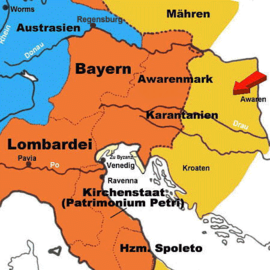
The Avar March (Latin: Provincia Avarorum; German: Awarenmark) was a southeastern frontier province of the Frankish Empire, established after successful Frankish campaigns and conquests of Avarian territories along the river Danube, to the east from the river Enns, in what is today Lower Austria and northwestern Hungary. Since the Frankish conquest in the late 8th century, there were several administrative changes in those regions. Territory along the river Danube, from the river Enns to the Vienna Woods, was ruled directly, as a frontier extension (march) of the Frankish Bavaria, while regions further to the east, up to the river Rába, were initially designated to remaining Avarian princes, under the Frankish supreme rule. During the 820s and 830s, additional administrative changes were made in the wider region of Frankish Pannonia, inhabited mainly by Pannonian Slavs. Territories of the remaining Avarian princes were fully incorporated, and Avars eventually disappeared from the region.[1][2][3][4]
Later during the 9th century, the region was contested between Eastern Frankish Kingdom and Great Moravia, while at the very beginning of the 10th century it was invaded and conquered by the Magyars. After the Battle of Lechfeld (955), territories along the river Danube, from the river Enns to the Vienna Woods, were reconquered by Germans, and new march was established (c. 972) thus creating the nucleus of the Margraviate of Austria.[5][6]